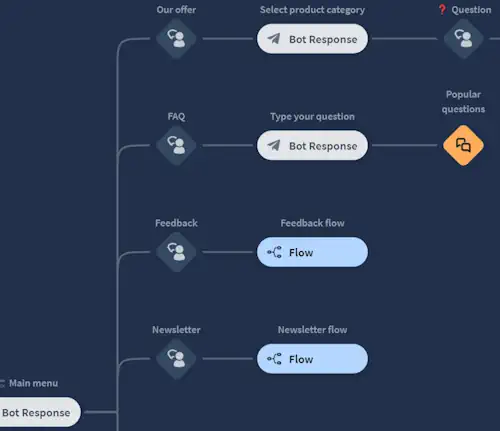Predictable, straightforward, efficient, controlled
A rule-based chatbot represents an automated communication interface that leverages a predefined rule set to interpret and respond to user inquiries. Operating within a meticulously structured framework, it ascertains user intents through the identification of specific keywords or phrases and delivers responses or executes actions based on logical pathways defined by the established rules.
Within the confines of a systematically engineered decision tree, the rule-based chatbot navigates through a set hierarchy of if/else conditions to discern the appropriate response or action, thereby maintaining strict adherence to programmed guidelines. This deterministic approach ensures that user inputs correlating with the defined rules are addressed with consistent, accurate, and rapid responses.
In a professional context, rule-based chatbots are paramount for scenarios that mandate absolute consistency, such as compliance-heavy industries or structured customer interactions, wherein the resolution pathways are clear-cut and predictable. Consequently, these chatbots excel in environments where inquiries can be adequately addressed through deterministic logic and predefined responses.
Characteristics of Rule-Based Chatbots
- Consistency: Ensures unwavering uniformity in responses, abiding strictly by the implemented rules.
- Deterministic Logic: Utilizes a well-defined decision tree to navigate through user interactions, providing clear, logical progressions.
- Scalability: Capably manages high-volume, straightforward interactions, enabling simultaneous engagement across numerous user sessions.
- Compliance Adherence: Offers an optimal solution for sectors where regulatory compliance and consistency in information dissemination are pivotal.
- Low Latency: Provides rapid responses to user queries, ensuring swift user interactions by directly mapping inputs to outputs without necessitating complex processing.
In essence, rule-based chatbots serve as a pivotal asset for organizations seeking to automate and systematize specific aspects of customer interaction, particularly where reliability and consistency are of paramount importance. These chatbots, while not adept at managing nuanced or contextually rich interactions, provide an unerring and efficient solution for structured, straightforward communication use-cases.
Rule-Based Decision Trees as a basis
- Interpretation of User Input: The chatbot examines user messages, identifying keywords or phrases that match its preprogrammed triggers.
- Navigation Through Logical Pathways: Based on identified triggers, the chatbot traverses a decision tree, a hierarchical model of predefined responses and pathways.
- Response Generation: The bot offers responses or executes actions based on the predetermined logic in its decision tree, which could range from providing information to executing a specific action like booking a ticket.
- End of Interaction: Either concludes the interaction based on provided outputs or loops back to an appropriate point in the decision tree for further assistance, based on user input.
Advantages of Rule-based Chatbots for Businesses
Rule-based chatbots provide a structured, predictable, and cost-effective solution for managing straightforward customer interactions by offering consistent responses, adhering to compliance, and efficiently handling multiple inquiries without requiring complex development or machine learning capabilities.
- Consistency: Rule-based chatbots ensure that responses to customer queries are uniform and consistent, maintaining a steady brand voice and information accuracy.
- Compliance: These chatbots can strictly adhere to regulatory and company policies, ensuring that all provided information is compliant and accurate.
- Scalability: Able to handle a large number of simultaneous interactions, they support scalable customer service without additional manpower costs.
- Reduced Costs: Minimizing the need for live agents for basic queries, rule-based chatbots can notably reduce operational costs in customer service.
- 24/7 Availability: Offering round-the-clock availability, they ensure that customer queries can be addressed at any time, enhancing customer experience.
- Instant Response: The ability to provide immediate answers to user queries enhances response time and customer satisfaction.
- Error Mitigation: Automated, predefined responses reduce the likelihood of errors, ensuring accurate information dissemination.
- Efficient Handling of Simple Interactions: Rule-based chatbots efficiently manage straightforward interactions and transactions, optimizing simple processes.
- Less complex Implementation: Typically less complex to build than AI chatbots, they can be deployed relatively quickly and efficiently.
- Controlled Customer Journey: They guide customers through a controlled, structured interaction pathway, streamlining processes like form submissions or bookings.
- Security: Reducing the need for human intervention in certain interactions can mitigate the risk of human error and enhance data security in sensitive processes.
- Resource Allocation: Allowing human agents to focus on more complex customer queries and issues by automating responses to routine inquiries.
Disadvantages of Rule-Based Chatbots
Rule-based chatbots can face limitations due to their inflexibility, lack of understanding of varied user inputs, inability to handle complex queries or learn from interactions, potential for user frustration, and challenges related to scaling, maintenance, and ensuring comprehensive and accurate responses to all possible inquiries:
- Limited Understanding: Can’t comprehend unanticipated queries.
- Inflexibility: Unable to adapt to varied conversational styles.
- Scaling Challenges: Difficult to manage expanding or varied queries.
- Handling Ambiguity: Struggles with unclear or vague user inputs.
- Dependency on Matches: Relies heavily on exact keyword/phrases.
- Maintenance Issues: Requires ongoing updates and adjustments.
- No Learning Capability: Cannot improve or learn from interactions.
- User Frustration: Can result in unsatisfactory user experiences.
- Lacks Personalization: Unable to remember or personalize interactions.
- Complex Query Inefficiency: Not suitable for multifaceted inquiries.
- Development Complexity: Building a comprehensive decision tree can be intricate.
- Quality Assurance: Ensuring all possible queries are addressed can be rigorous.

